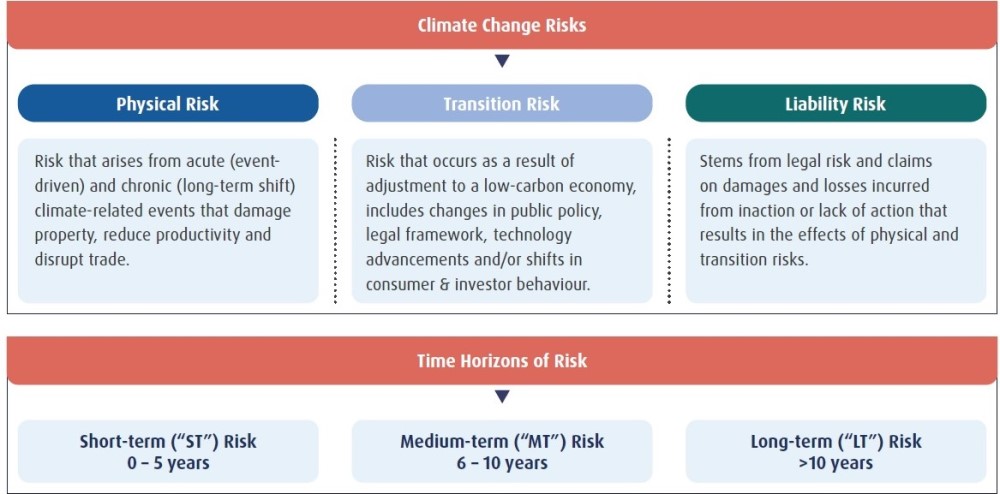- Sustainability >
- Sustainability Risk Governance
Sustainability Risk Governance

The Bank is committed to integrating ESG and VBI considerations into our business practices that contribute to a better future for all.
Sustainability Risk Management

There is a growing need for organisations to embed sustainability ideals in ensuring the long-term viability of businesses. As it continues to evolve, it is vital for the Bank to continue growing its business in a sustainable and environmentally friendly manner through conscious consideration of potential impacts on our customers, stakeholders, communities and the planet. This drives us to advance in tandem with these sustainability developments and aspirations. Our dedication and efforts in promoting sustainability both in our business operations as well as to our suppliers and customers has provided us with the foundation to achieve our responsibilities with regard to ESG, and in doing so, align with investor expectations and regulatory requirements.
Accountability in embedding sustainable practices into the business is driven from the top. The Bank’s Board of Directors leads the company’s approach to sustainability, including the management of ESG risks and opportunities. The Board Risk Management Committee complements the Board in its responsibility for ensuring sustainability efforts and policies are in line with the core principles and objectives of our institution.
The Bank’s Sustainability Risk Governance Framework addresses potential ESG risks that may arise during the implementation of our business strategies, policies and initiatives. This framework provides a structured approach towards identifying, evaluating, quantifying, monitoring, mitigating and reporting of ESG risks. It acts as a guide for us to adopt pragmatic measures to ensure sustainable value to our stakeholders is delivered whilst generating a positive impact to the communities and environments that we operate in. As the Bank’s sustainability approach evolves, we will continue to improve transparency in our practices and policies as well as improve communication with our stakeholders.

We continue to disclose our approach towards managing climate risks and opportunities aligned with recommendations of The Task Force on Climate-related Financial Disclosure (TCFD). This year, we have taken guidance from BNM’s TCFD Application Guide in developing our climate-related disclosures around the four thematic areas: Governance, Strategy, Risk Management and Metrics and Targets. As outlined in the guide, we have addressed and discussed most of the Basic recommendations in the table in the link below:
Sustainability Risk Management
Since 2019, Sustainability Risks have already been incorporated into our overall Risk Management Framework, where an enterprise view of all the risks that are material to the Bank is taken and acted on by Management of the Bank, with oversight provided by the Board of Directors and the delegated Committees of the Bank.
Our sustainability strategic priorities are set by the Board of Directors, which is responsible for ensuring sound governance and effective oversight of the Bank’s Sustainability Strategy. The Board of Directors delegates the review of management’s implementation of the Bank’s Sustainability strategy to the Board Risk Management Committee (“BRMC”).
The Sustainability Committee and Sustainability Working Committee are responsible for implementing the Sustainability strategies, and in managing and mitigating identified ESG risks which includes physical and transition risks. Management provides periodic reporting to the BRMC on execution statuses as well as the results attained. This is coordinated and monitored by the Sustainability department and the Sustainability Risk department.
Climate Change Risk and Opportunities
The Bank is exposed to three (3) climate change risks (Physical, Transition and Liability Risk) spreading across most key assets of the Bank. Within these climate change risk categories, we have identified a number of risk factors which we monitor over the short (0-5 years), medium (6-10 years) and long-term (10 years >) horizon.

Although Climate Change presents its risks, the Bank has introduced initiatives that mitigates and adapts to these risks, which allow the Bank to tap potential opportunities. The opportunity areas identified include resource efficiency, the adoption of low-emission energy sources, development of new green products and services, access to new markets and further strengthening of the Bank’s resiliency against risks in general.
Based on the TCFD recommendations, we have conducted a preliminary qualitative assessment of climate change risks and opportunities and their potential positive financing, business and operational impact as described in the proceeding sub-sections.
Hong Leong Bank Group Sustainability Risk Governance Framework
The Bank’s Sustainability Risk Governance Framework was developed to address Environmental, Social and Governance (“ESG”) risks that may arise as we implemented our business strategies, policies and initiatives. The Bank is guided by the Framework in taking pragmatic steps to ensure it delivers sustainable value to our stakeholders whilst creating positive impact to the communities and environments we operate in. The Framework discussed herein provides a structured approach towards identifying, evaluating, monitoring, mitigating and reporting of ESG risks. We hope to improve transparency in our practices and policies, and in improving dialogue with our various stakeholders.
